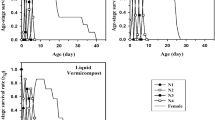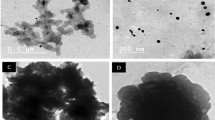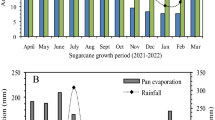Abstract
Myzus persicae (Sulzer) is a polyphagous aphid that causes chlorosis, necrosis, stunting, and reduce growth rate of the host plants. In this research, the effects of Zinc sulfate and vermicompost (30%), Bacillus subtilis, Pseudomonas fluorescens, Glomus intraradices, G. intraradices × B. subtilis, and G. intraradices × P. fluorescens compared to control was investigated on the growth characters of Capsicum annuum L. and biological parameters of M. persicae. Different fertilizers caused a significant effect on growth characters of C. annuum and biological parameters of M. persicae. The highest plant growth was observed on Zinc sulfate and B. subtilis treated plants, and the lowest was on control. Increase in the amount of specific leaf area (SLA) (0.502 mm2 mg−1) was significantly higher in the B. subtilis than other fertilizer treatments. The longest (10.3 days) and the shortest (5.3 days) developmental times of M. persicae nymphs were observed on 30% vermicompost and Zinc sulfate treatments, respectively. The lowest adult longevity periods of M. persicae (11.2 and 11.3 days) were observed on G. intraradices × B. subtilis and 30% vermicompost treatments, respectively, and the longest ones (16.4 days) on Zinc sulfate. The highest rate of nymphal mortality and the lowest amount of nymphal growth index (NGI) were recorded on 30% vermicompost. The nymphs reared on Zinc sulfate treatment had the lowest rate of nymphal mortality and the highest amount of NGI. Thus, amending the soil with 30% vermicompost had a significantly negative effect on the biological parameters of M. persicae that can be used as an ecological control tactic for this pest.


Similar content being viewed by others
References
Abdel-Kader MM, El-Mougy NS, Lashin SM (2012) Efficacy of different plant resistance inducers against downy and powdery mildew diseases of pepper under plastic houses conditions. J Appl Sci Res 8:3415–3423
Abu-Zahra T (2012) Vegetative, flowering and yield of sweet pepper as influenced by agricultural practices. Middle East J Sci Res 11:1220–1225
Arancon NQ, Edwards CA, Yardim EN, Oliver T, Byrnem RJ, Keeney G (2006) Suppression of two-spotted spidermite (Tetranychus urticae), mealy bugs (Pseudococcus sp.) and aphid (Myzus persicae) populations and damage by vermicomposts. Crop Prot 26:29–39
Baskaran P, Narayanasamy P, Pari A (1985) The role of potassium in incidence of insect pests among crop plants, with particular reference to rice. In: Role of potassium in crop resistance to insect pests. Research series no. 3. Potash Research Institute of India, Guragaon, pp 63–68
Bentz JA, Reeves IJ, Barbosa P, Francis B (1995) Nitrogen fertilizer effect on selection, acceptance and suitability of Euphorbia pulcherrima (Euphorbiaceae) as a host plant to Bemisia tabaci (Homoptera: Aleyrodidae). Environ Entomol 24:40–45
Biradar AP, Sunita ND, Teggelli RG, Devaranavadgi SB (1998) Effect of vermicomposts on the incidence of subabul psyllid. Insect Environ 4:55–56
Blackman RL, Eastop VF (2000) Aphids on the World’s crops, Second edn. John Wiley & Sons with the Natural History Museum, London
Bloemberg GV, Lugtenberg BJJ (2001) Molecular basis of plant growth promotion and biocontrol by rhizobacteria. Curr Opin Pl Biol 4:343–350
Bolandandam J, Barker H, Fenton B (2004) Differences in potato leafroll transmitting ability of individual genotypes of Scottish Myzus persicae with different susceptibilities to Lambda- cyhalothrin insecticide. Proc. 15th Intl. Plant Protect. Cong., Beijing, China
Bong CFJ, Sikorowski PP (1991) Effects of cytoplasmic polyhedrosis virus and bacterial contamination on growth and development of the corn earworm, Helicoverpa zea. J Invertebr Pathol 57:406–412
Carey JR (1993) Applied demography for biologists with special emphasis on insects. Oxford University Press Inc., 205 p
Carey JR (2001) Insect biodemography. Annu Rev Entomol 46:79–110
Chau LM, Heong KL (2005) Effects of organic fertilizers on insect pest and diseases of rice. Omonrice 13:26–33
Dale D (1988) Plant mediated effects of soil mineral stress on insects. In: Heinrich EA (ed) Plant stress insect interactions. John Wiley & Sons New York, USA, pp 35–110
Deepa N, Kaur C, George B, Singh B, Kapoor HC (2007) Antioxidant constituents in some sweet pepper (Capsicum annuum L.) genotypes during maturity. LWT-Food Sci Technol 40:121–129
Edwards CA, Arancon NQ, Vasko-Bennett M, Askar A, Keeney G, Little B (2009) Suppression of green peach aphid (Myzus persicae) (Sulz.), citrus mealy bug (Planococcus citri) (Risso), and two spotted spider mite (Tetranychus urticae) (Koch.) attacks on tomatoes and cucumbers by aqueous extracts from vermicomposts. Crop Prot 28:1–14
Evans GC (1972) The quantitative analysis of plant growth. Blackwell Scientific, Oxford
Fenton B, Kasprowicz L, Malloch G, Pickup J (2010) Reproductive performance of asexual clones of the peach-potato aphid, Myzus persicae, (Homoptera: Aphididae), colonising Scotland in relation to host plant and field ecology. Bull Entomol Res 100:451–460
Foster SP, Denholm I, Harling ZK, Moores GD, Devonshire AL (1998) Intensification of insecticide resistance in UK field populations of the peach-potato aphid, Myzus persicae (Hemiptera: Aphididae) in 1996. Bull Entomol Res 88:127–130
Frantz DJ, Gardner J, Hoffmann PM, Jahn MM (2004) Greenhouse screening of Capsicum accessions for resistance to green peach aphid (Myzus persicae). Hort Science 39:1332–1335
Gopinath KA, Saha S, Mina BL, Pande H, Srivastva AK, Gupta HS (2009) Bell pepper yield and soil properties during conversion from conventional to organic production in India Himalayas. Sci Hortic 122:339–345
Greenleaf WH (1986) Breeding vegetable crops, chapter 3. In: Basset MJ (ed) Pepper breeding. The AVI Publishing Company Inc., Westport, Connecticut, pp 67–134
Hammerschmidt R, Kuc J (1995) Induced resistance to disease in plants. Kluwer Academic Publishers, Dordrecht, p 182
Haukioja E, Ossipov V, Lempa K (2002) The interactive effects of leaf maturation and phenolics on consumption and growth of a geanetrid moth. Futrand Exp Appl 104:125–136
Hogendorp BK, Cloyd RA, Swiader JM (2006) Effect of nitrogen fertility on reproduction and development of citrus mealybug, Planococcus citri Risso (Homoptera: Pseudococcidae), feeding on two colors of coleus, Solenostemon scutellarioides L. Environ Entomol 35:201–211
Howard LR, Talcott ST, Brenes CS, Villalon B (2000) Changes in phytochemical and antioxidant activity of selected pepper cultivars (Capsicum spp.) as influenced by maturity. J Agric Food Chem 48:1713–1720
Kale RD, Mallesh BC, Kubra B, Bagyaraj DJ (1992) Influence of vermicompost application on the available macronutrients and selected microbial populations in a paddy field. Soil Biol Biochem 24:1317–1320
Kristek S, Kristek A, Pavlovic H (2005) The influence of mycorrhizal fungi (Glomus sp.) on field pea plant survival and growth in drought caused stress conditions. Pl Soil Environ 51:385–389
Luong MC, Heong KL (2005) Effects of organic fertilizers on insect pest and diseases of rice. Omonrice 13:26–33
Mardani-Talaee M, Zibaee A, Nouri-Ganblani G, Razmjou J (2016a) Chemical and organic fertilizers affect physiological performance and antioxidant activities in Myzus persicae (Hemiptera: Aphididae). Invert Surviv J 13:122–133
Mardani-Talaee M, Nouri-Ganblani G, Razmjou J, Hassanpour M, Naseri B, Asgharzadeh A (2016b) Effects of chemical, organic and bio-fertilizers on some secondary metabolites in the leaves of bell pepper (Capsicum annuum) and their impact on life table parameters of Myzus persicae (Hemiptera: Aphididae). J Econ Entomol 109:1–10
Marinari S, Masciandaro G, Ceccanti B, Grego S (2000) Influence of organic and mineral fertilizers on soil biological and physical properties. Bioresour Technol 72:9–17
Meyer GA (2000) Interactive effects of soil fertility and herbivory on Brassica nigra. Oikos 22:433–441
Meyer JS, Ingersoll CG, McDonald LL, Boyce MS (1986) Estimating uncertainty in population growth rates: jackknife vs. bootstrap techniques. Ecology 67:1156–1166
Minitab lnc. 1994. Philadelphia, PA, USA. www.minitab.com
Mullins MG, Bouquet A, Williams LE (1992) Biology of the grapevine. Cambridge University Press, Cambridge
Olaniyi JO, Ojetayo AE (2010) The effect of organomineral and inorganic fertilizers on the growth, fruit yield and quality of pepper (Capsicum frutescence). J Anim Pl Sci 8:1070–1076
Oliveira MD, Barbosa PRR, Silva-Torres CSA, Silva RR, Barros EM, Torres JB (2014) Reproductive performance of striped mealy bug Ferrisia virgata Cockerell (Hemiptera: Pseudococcidae) on water-stressed cotton plants subjected to nitrogen fertilization. Arth Plant Int 8:461–468
Palukaitis P, Garcia-Arenal F (2003) Cucumber mosaic virus. AAB. Descriptions of Plant Viruses, No. 400
Parihar SBS, Upadhyay NC (2001) Effect of fertilizers (NPK) on incidence of leaf hoppers and mite in potato crop. Insect Environ 7:10–11
Patriquin DG, Baines D, Abboud A (1995) Diseases, pests and soil fertility. In: Cook HF, Lee HC (eds) Soil Management in Sustainable Agriculture. Wye College Press, Wye, pp 161–174
Pinton R, Cakmak I, Marschner H (1993) Effect of zinc deficiency on proton fluxes in plasma membrane-enriched vesicles isolated from bean roots. J Exp Bot 44:623–630
Qingwen Z, Ping L, Gang W, Qingnian C (1998) The biochemical mechanism of induced resistance of cotton to cotton bollworm by cutting of young seedling at plumular axis. Acta Phytophylacica Sin 25:209–212
Ramamoorthy V, Viswanathan R, Raguchander T, Pkakasam V, Samivappan R (2001) Induction of systemic resistance by plant growth promoting rhizobacteria in crop plants against pests and diseases. Crop Prot 20:1–11
Ramesh P (2000) Effects of vermicomposts and vermicomposting on damage by sucking pests to ground nut (Arachis hypogea). Indian J Agr Sci J 70:334
Rao KR (2002) Induced host plant resistance in the management of sucking insect pests of groundnut. Ann Pl Protect Sci 10:45–50
Razmjou J, Mohammadi M, Hassanpour M (2011) Effect of vermicompost and cucumber cultivar on population growth attributes of the melon aphid (Hemiptera: Aphididae). J Econ Entomol 104:1379–1383
Robert Y, Trefor Woodford JA, Ducray-Bourdin DG (2000) Some epidemiological approaches to the control of aphid-borne virus diseases in seed potato crops in northern Europe. Virus Res 71:33–47
Saha S, Mina BL, Gopinath KA, Kundu S, Gupta HS (2008) Relative changes in phosphatase activities as influenced by source and application rate of organic composts in field crops. Bioresour Technol 99:1750–1757
Salim M (2002) Effects of potassium nutrition on growth, biomass and chemical composition of rice plants and on host-insect interaction. Pak J Agric Res 17:14–21
Samiayyan K, Janarathanan R (1990) Influence of K in combination with N on the incidence of BPH in rice. Potassium Res 6:36–41
Schade JD, Kyle M, Hobbie SE, Fagan WF, Elser JJ (2003) Stoichiometric tracking of soil nutrients by a desert insect herbivore. Ecol Lett 6:96–101
Setamou M, Schulthess F, Bosque-Perez NA, Poehling HM, Borgemeister C (1999) Bionomics of Mussidia nigrivenella (Lepidoptera: Pyralidae) on three host plants. J Chem Ecol 89:465–471
Smith SE, Read DJ (2008) Mycorrhizal symbiosis, 3rd edn. Elsevier, New York
Sokal RR, Rohlf FJ (1981) The principles and practice of statistics in biological research. Biometry, New York, 843 pp
Spiegel-Roy P, Goldschmidt E (2008) Biology of citrus. Cambridge University Press, p 140–184
Stevenson PC, Anderson JC, Blaney WM, Simmonds MSJ (1993) Developmental inhibition of Spodoptera litura (Fab.) larvae by a novel caffeoylquinic acid from the wild ground, Arachis paraguariensis (Chodat and Hassl.). J Chem Ecol 19:2917–2933
Throop HL, Lerdau MT (2004) Effects of nitrogen deposition on insect herbivory: implications for community and ecosystem processes. Ecosystems 7:109–133
Urabe J, Sterner RW (2001) Contrasting effects of different types of resource depletion on life- history traits in Daphnia. Funct Ecol 15:165–174
van de Rive JAC, Murtry JA, Huffaker CB (1972) Ecology of mites and their natural enemies: a review: III. Biology, ecology, and pest status, and host plant relations of tetranychids. Hilgardia 41:354–432
van Lenteren JC, Noldus LPJJ (1990) Whitefly plant relationship: behavioral and ecological whitefly their bionomics. In: Gerling D (ed) Pest status and management. Intercept, Andover
Vidhyasekaran P, Muthamilan M (1999) Evaluation of powder formulation of Pseudomonas yuorescens Pf1 for control of rice sheath blight. Biocontrol Sci Techn 9:67–74
Wafsy E, El-Din (1995) Growth regulators and flowering. Academic Bookshop, Modern Egyptian Press, p 503–510
Wolk M, Sarkar S (1994) Antagonism in vitro of Bacillus sp., against Rhizoctonia solani and Pythium spp. Anz Schädlingskd Pfl Umwelt 67:1–5
Xing L, Ding Z, Wenxiang Y, Li D, Daqun L (2003) A study on the effect of Bacillus on downy mildew of cucumber. Pl Prot 29:25–27
Yardim EN, Arancon NQ, Edwrads CA, Oliver TO, Byrne R (2006) Suppression of hornworm (Manduca quinqemaculata) and cucumber beetles (Acalymma vittatum and Diabotrica undecimpunctata) populations and damage by vermicomposts. Pedobiologia 50:23–29
Zehnder G, Kloepper J, Yao C, Wei G (1997) Induction of systemic resistance in cucumber against cucumber beetles (Coleoptera: Chrysomelidae) by plant growth promoting rhizobacteria. J Econ Entomol 90:391–396
Acknowledgments
This research is financially supported by the University of Mohaghegh Ardabili, (Ardabil, Iran), which is greatly appreciated.
Author information
Authors and Affiliations
Corresponding author
Additional information
Edited by J B Torres – UFRPE
Rights and permissions
About this article
Cite this article
Mardani-Talaee, M., Razmjou, J., Nouri-Ganbalani, G. et al. Impact of Chemical, Organic and Bio-Fertilizers Application on Bell Pepper, Capsicum annuum L. and Biological Parameters of Myzus persicae (Sulzer) (Hem.: Aphididae). Neotrop Entomol 46, 578–586 (2017). https://doi.org/10.1007/s13744-017-0494-2
Received:
Accepted:
Published:
Issue Date:
DOI: https://doi.org/10.1007/s13744-017-0494-2




